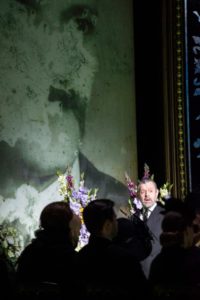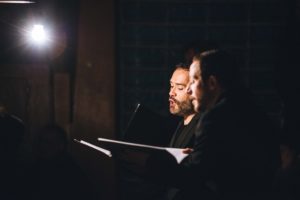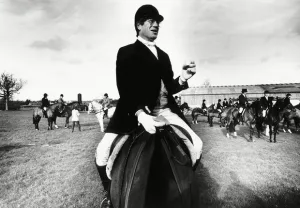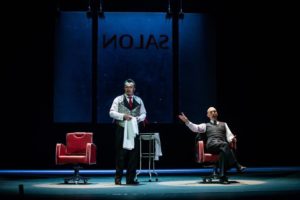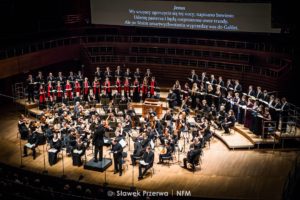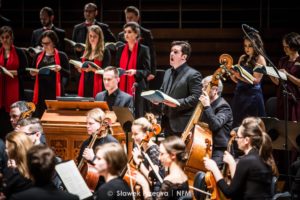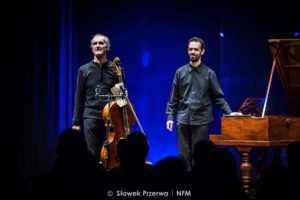Wakacje w kostnicy
Aschenbach umarł. I to dość dawno temu. Świadczy o tym olbrzymie zdjęcie w czarnej, inkrustowanej ramie – zatarte, pokryte pleśnią niczym porcelanowy portret na zapomnianym nagrobku. Przed zdjęciem stoją kwiaty w wazonach i statyw podtrzymujący śnieżnobiały wieniec. Obok fortepian, zamalowany czarną matową farbą, i rzędy krzeseł, zajętych przez schludnie ubranych żałobników. Po prawej stos monstrualnie wielkich tulipanów o sinofioletowych płatkach. Za chwilę ogarnięty niemocą twórczą pisarz spotka Podróżnika, który zachęci go do wyjazdu na południe. Czy jesteśmy u wrót kaplicy cmentarnej w Monachium, czy w jakimś dziwnym zakładzie pogrzebowym, gdzie rytuał ciągnie się od tak dawna, że fotografia denata zdążyła porosnąć grzybem?
Narracja Brittenowskiej Śmierci w Wenecji wypełnia dwa akty, podzielone na sceny przechodzące z jednej do drugiej raptownie, trochę jak w dynamicznym montażu filmowym, pozornie bez związku, na podobieństwo halucynacji albo sennych majaków. Kompozytor i librecistka Myfanwy Piper próbowali w ten sposób wymknąć się z pułapki dosłowności, której Mann uniknął dzięki zastosowaniu ironii literackiej i wieloznacznej gry między autorem a tropiącym sensy czytelnikiem. Operę Brittena można więc zinterpretować jako zapis agonii pisarza, w której „figury śmierci” (Podróżnik, Podstarzały Dandys, Stary Gondolier, Dyrektor Hotelu, Fryzjer Hotelowy i Pierwszy Muzyk), złowieszczy Głos Dionizosa i niejednoznaczny Głos Apollina, a nawet sam Tadzio, okażą się tylko efektem wzmożonej aktywności konającego mózgu. Graham Vick, reżyser najnowszej inscenizacji w Deutsche Oper Berlin, poszedł jednak krok dalej. Wygląda na to, że jego Aschenbach wrócił z zaświatów, by jeszcze raz stanąć oko w oko ze śmiercią i odtworzyć swoją koszmarną podróż na dno upodlenia.
Akt I, scena 1. Po prawej Paul Nilon (Gustaw von Aschenbach). Fot. Marcus Lieberenz.
Szkopuł w tym, że w koncepcji Vicka zabrakło miejsca na wizję czystego piękna, która wdziera się podstępnie w poukładane życie pisarza. Scena od samego początku tonie w barwach rozkładu: ropnych żółcieniach, martwej zieleni, sinej purpurze i zmatowiałej czerni (scenografia Stuart Nunn, reżyseria świateł Wolfgang Göbbel). Nie ma kontrastu między rozsłonecznioną plażą Lido a mrokiem smrodliwych weneckich kanałów. W ogóle nie ma Wenecji. Wszystkie plenery zastępuje sterta przerośniętych tulipanów, wszystkie epizody we wnętrzach rozgrywają się pod czarną ramą, z której w II akcie znika nawet zdjęcie Aschenbacha. Główny bohater, dziwnie zdystansowany wobec otaczającej go rzeczywistości, miota się wśród nielicznych i wciąż tych samych rekwizytów. Ustawione rzędami krzesła zastępują pokład statku, hotelową restaurację i salon fryzjerski. Żałobny wieniec z białych kwiatów trafia w pewnym momencie na szyję Tadzia, zwycięzcy chłopięcych „igrzysk” na plaży. W ledwo naszkicowanych, trudnych do zidentyfikowania przestrzeniach bez reszty królują pożądanie i śmierć. Banda drobnych handlarzy osacza pisarza jak tłum napalonych dziwek i alfonsów, wykonując pod jego adresem gesty o niedwuznacznie erotycznym zabarwieniu. Aschenbach nie brzydzi się ulicznego fetoru i woni środków dezynfekujących, tylko własnej chuci. Unoszące się nad miastem widmo indyjskiej cholery staje się metaforą degrengolady moralnej. Nie o piękno i prawdę tu chodzi, nie o konflikt apollińsko-dionizyjski, lecz o żałosny dramat wdowca, który na stare lata odkrył w sobie homoseksualistę i pedofila.
Tak spłycone, w gruncie rzeczy mieszczańskie i pruderyjne odczytanie Śmierci w Wenecji zdumiewa w drugiej dekadzie XXI wieku. Na domiar złego Graham Vick postanowił uśmiercić Tadzia, który w finale ginie z rąk bandy rozwydrzonych rówieśników. Aschenbach tuli go niczym Matka Boska martwego Chrystusa, po czym odkłada zwłoki i wymyka się za kulisy. Czyżby Apollo padł ostatecznie w starciu z Dionizosem? Czy Tadzio musiał umrzeć, żeby pisarz odważył się okazać mu czułość? A może cała ta opowieść była tylko przestrogą z zaświatów, by nie ulegać własnym popędom? Nie mam pojęcia. W ostatniej scenie dostrzegłam raczej niemoc reżysera, który bezładnie poprowadzoną narrację postanowił przynajmniej domknąć obrazoburczą konkluzją. Jedyne, co w tej inscenizacji wzbudziło mój szczery podziw, to decyzja Vicka, by role Tadzia, jego rodziny i towarzyszy powierzyć nie tancerzom, lecz aktorom, idealnie dobranym pod względem fizycznym (drobniutki Rauand Taleb i wyższa o dwie głowy Lena Natus jako jego matka), realizującym swoją pantomimę z pełnym zaangażowaniem, a zarazem uroczą, bardzo przekonującą niezdarnością (świetna choreografia Rona Howella).
Paul Nilon i Rauand Taleb (Tadzio). Fot. Marcus Lieberenz.
Szczęśliwie strona muzyczna przedstawienia w pełni wynagradza nieudaną robotę reżyserską. Zespół Deutsche Oper gra roziskrzonym, selektywnym dźwiękiem, idealnie wyważonym w proporcjach między grupami, a przy tym pięknie zróżnicowanym w odrębnych, wyróżnionych przez Brittena planach orkiestrowych – w „azjatyckiej”, stylizowanej na gamelan muzyce Tadzia, w posępnych zwiastunach śmierci (gdzie drzewo łączy się z brzmieniem tuby), w karykaturalnym połączeniu motywu zarazy z „nieziemskim” portretem chłopca (scena gorączkowego snu Aschenbacha). Prowadzący całość Donald Runnicles nie ustrzegł się wprawdzie kilku dłużyzn w I akcie, trzeba jednak przyznać, że sama opera nabiera tempa dopiero z chwilą, gdy pisarz wyrzuci z siebie wstydliwe „I – love you” na zakończenie siódmego obrazu. Paul Nilon, znakomity tenor liryczny, znany przede wszystkim z ról w operach barokowych i klasycystycznych, zadebiutował w partii Aschenbacha w 2015 roku, w Garsington Opera. Niewielkie rozmiary tamtejszej sceny i klarowna reżyseria Paula Currana z pewnością ułatwiły mu zadanie. Z trudną akustyką berlińskiego teatru walczył długo, z początku głosem nadmiernie rozwibrowanym i ubogim w alikwoty. W II akcie dał z siebie wszystko: stworzył postać niezmiernie złożoną pod względem psychologicznym, poparłszy swoją interpretację ogromną siłą wyrazu i nieskazitelną dykcją. Prawdziwym bohaterem wieczoru okazał się jednak Seth Carico w siedmiu rolach alter ego pisarza i Głosu Dionizosa: prawdziwy bas-baryton o przepięknej barwie, dźwięczny we wszystkich rejestrach włącznie z szyderczym falsetem. Gorzej spisał się Tai Oney (Głos Apollina), pełny i kolorowy męski sopran, zbyt jednak histeryczny w brzmieniu. Z postaci drugoplanowych wyróżnił się Andrew Dickinson (Portier), od ubiegłego sezonu związany na stałe z DOB, gdzie zabłysnął między innymi w roli Nowicjusza, w niedawnej inscenizacji Billy’ego Budda, wyreżyserowanej przez Davida Aldena. Na osobną pochwałę zasłużył chór – za wielką kulturę emisji, muzykalność w prowadzeniu frazy i stopliwość dźwięku.
Paul Nilon i Seth Carico. Fot. Marcus Lieberenz.
W 2009 roku, kiedy Runnicles objął dyrekcję artystyczną Deutsche Oper i zapowiedział, że wprowadzi dzieła Brittena do stałego repertuaru berlińskiej sceny, rozległy się głosy sprzeciwu: „Britten? To się u nas nie przyjmie”. Na szczęście nie posłuchał. W ciągu niespełna czterech lat wystawił w Berlinie Petera Grimesa, Billy’ego Budda, Gwałt na Lukrecji i Śmierć w Wenecji. W grudniu 2016 przedłużono mu kontrakt do 2022 roku. Zobaczymy, co będzie dalej, choć po doświadczeniach z inscenizacją Vicka wolałabym tylko posłuchać.

